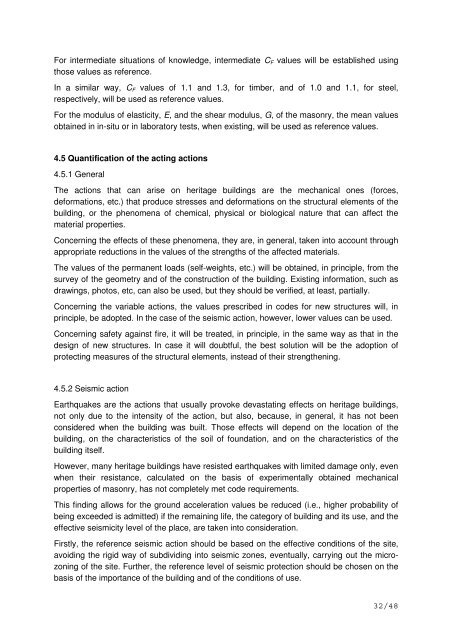Guide for the Structural Rehabilitation of Heritage ... - Test Input
Guide for the Structural Rehabilitation of Heritage ... - Test Input
Guide for the Structural Rehabilitation of Heritage ... - Test Input
You also want an ePaper? Increase the reach of your titles
YUMPU automatically turns print PDFs into web optimized ePapers that Google loves.
For intermediate situations <strong>of</strong> knowledge, intermediate C F values will be established usingthose values as reference.In a similar way, C F values <strong>of</strong> 1.1 and 1.3, <strong>for</strong> timber, and <strong>of</strong> 1.0 and 1.1, <strong>for</strong> steel,respectively, will be used as reference values.For <strong>the</strong> modulus <strong>of</strong> elasticity, E, and <strong>the</strong> shear modulus, G, <strong>of</strong> <strong>the</strong> masonry, <strong>the</strong> mean valuesobtained in in-situ or in laboratory tests, when existing, will be used as reference values.4.5 Quantification <strong>of</strong> <strong>the</strong> acting actions4.5.1 GeneralThe actions that can arise on heritage buildings are <strong>the</strong> mechanical ones (<strong>for</strong>ces,de<strong>for</strong>mations, etc.) that produce stresses and de<strong>for</strong>mations on <strong>the</strong> structural elements <strong>of</strong> <strong>the</strong>building, or <strong>the</strong> phenomena <strong>of</strong> chemical, physical or biological nature that can affect <strong>the</strong>material properties.Concerning <strong>the</strong> effects <strong>of</strong> <strong>the</strong>se phenomena, <strong>the</strong>y are, in general, taken into account throughappropriate reductions in <strong>the</strong> values <strong>of</strong> <strong>the</strong> strengths <strong>of</strong> <strong>the</strong> affected materials.The values <strong>of</strong> <strong>the</strong> permanent loads (self-weights, etc.) will be obtained, in principle, from <strong>the</strong>survey <strong>of</strong> <strong>the</strong> geometry and <strong>of</strong> <strong>the</strong> construction <strong>of</strong> <strong>the</strong> building. Existing in<strong>for</strong>mation, such asdrawings, photos, etc, can also be used, but <strong>the</strong>y should be verified, at least, partially.Concerning <strong>the</strong> variable actions, <strong>the</strong> values prescribed in codes <strong>for</strong> new structures will, inprinciple, be adopted. In <strong>the</strong> case <strong>of</strong> <strong>the</strong> seismic action, however, lower values can be used.Concerning safety against fire, it will be treated, in principle, in <strong>the</strong> same way as that in <strong>the</strong>design <strong>of</strong> new structures. In case it will doubtful, <strong>the</strong> best solution will be <strong>the</strong> adoption <strong>of</strong>protecting measures <strong>of</strong> <strong>the</strong> structural elements, instead <strong>of</strong> <strong>the</strong>ir streng<strong>the</strong>ning.4.5.2 Seismic actionEarthquakes are <strong>the</strong> actions that usually provoke devastating effects on heritage buildings,not only due to <strong>the</strong> intensity <strong>of</strong> <strong>the</strong> action, but also, because, in general, it has not beenconsidered when <strong>the</strong> building was built. Those effects will depend on <strong>the</strong> location <strong>of</strong> <strong>the</strong>building, on <strong>the</strong> characteristics <strong>of</strong> <strong>the</strong> soil <strong>of</strong> foundation, and on <strong>the</strong> characteristics <strong>of</strong> <strong>the</strong>building itself.However, many heritage buildings have resisted earthquakes with limited damage only, evenwhen <strong>the</strong>ir resistance, calculated on <strong>the</strong> basis <strong>of</strong> experimentally obtained mechanicalproperties <strong>of</strong> masonry, has not completely met code requirements.This finding allows <strong>for</strong> <strong>the</strong> ground acceleration values be reduced (i.e., higher probability <strong>of</strong>being exceeded is admitted) if <strong>the</strong> remaining life, <strong>the</strong> category <strong>of</strong> building and its use, and <strong>the</strong>effective seismicity level <strong>of</strong> <strong>the</strong> place, are taken into consideration.Firstly, <strong>the</strong> reference seismic action should be based on <strong>the</strong> effective conditions <strong>of</strong> <strong>the</strong> site,avoiding <strong>the</strong> rigid way <strong>of</strong> subdividing into seismic zones, eventually, carrying out <strong>the</strong> microzoning<strong>of</strong> <strong>the</strong> site. Fur<strong>the</strong>r, <strong>the</strong> reference level <strong>of</strong> seismic protection should be chosen on <strong>the</strong>basis <strong>of</strong> <strong>the</strong> importance <strong>of</strong> <strong>the</strong> building and <strong>of</strong> <strong>the</strong> conditions <strong>of</strong> use.32/48
















